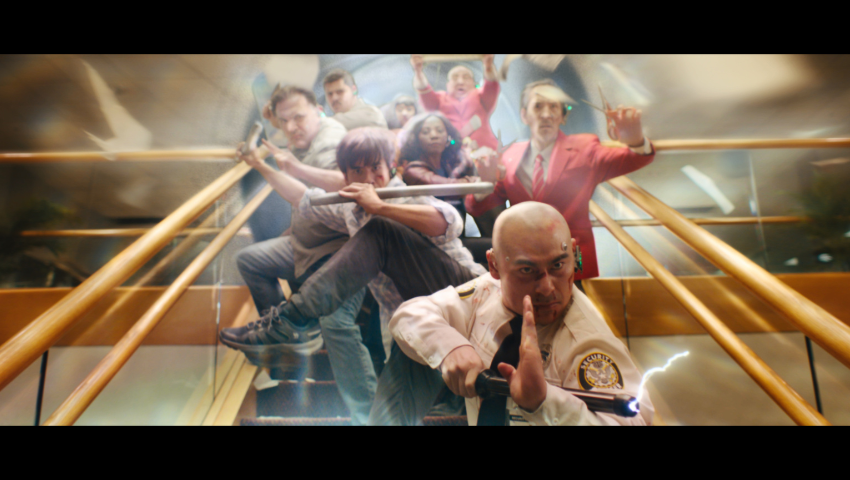Image Credit: Everything Everywhere All At Once @ 2022 Zak Stoltz, Ethan Feldbau, Ben Brewer, Jeff Desom, Matt Wauhkonen, Evan Halleck
Introducing … the “Bagel Boys”! The VFX team behind the 11-time Academy Award-nominated film and SIGGRAPH 2022 Electronic Theater project, “Everything Everywhere All At Once,” is made up of a blend of different talents that come together to create something magical — very similar to the seasonings that make up an everything bagel (not the one that threatens to destroy the multiverse). We sat down with Zak Stoltz, Ethan Feldbau, Ben Brewer, Jeff Desom, Matt Wauhkonen, and Evan Halleck to pull back the curtain and showcase their handmade visual effects, their collaboration in handling nearly 500 shots among only six artists, and the friendship that blossomed along the way.
SIGGRAPH: Share some background about your SIGGRAPH 2022 Electronic Theater project, “Everything Everywhere All At Once.” How did you all get involved in this film?
Zak Stoltz (ZS): I started working with Daniel Kwan and Daniel Scheinert about 10 years ago on visual effects for music videos, and that’s where I met Ben Brewer. Then over the last decade, we worked together a lot. The Daniels did “Swiss Army Man” with a traditional post house, then on “Everything Everywhere All At Once,” then they decided they wanted to get back to how they used to do things and have more direct interaction with the visual effects artists, so they asked me to come on as the visual effects supervisor in 2019. At that point, I have been working a lot with Ethan and Ben, so I contacted them about getting involved as a three-man team. As we were working on shots, we realized we needed more help because three people for 500 visual effect shots weren’t going to cut it, so we brought on the rest of the team.
Ethan Feldbau (EF): I came on directly after Zak in 2019. It was kind of a roundabout way that I got pulled on because I recently worked with Zak on a show that he had directed called “Breakarate,” for which I did the visual effects. We worked together very well, and he asked me if I wanted to join him on “Everything Everywhere All At Once.” Turns out, I already had a legacy with a lot of the crew — I met the Daniels and Ben back in college. When the Daniels first moved out to Los Angeles, they would contact me regarding their art department, and we did a couple of shows and one music video. In this case, I came on for visual effects but with a bit of an art and design component as well.
Ben Brewer (BB): In 2016, I asked Dan Kwan what he was working on and he mentioned he was writing a script about a multiverse where someone realizes they are the worst version of themselves across infinite universes, and I thought that sounded hilarious. I was able to read early drafts of the script, so I was aware of it for quite a while. When the momentum started rolling on this project, Zak, Ethan, and I met at Dan Kwan’s house, and they walked through all their visual references for what they wanted the effects to look like, and it was an incredible presentation. I wish that meeting made its way into the behind-the-scenes footage. I went from just a friend reading their script to becoming a visual effects artist for the film.
Jeff Desom (JD): I’ve known the Daniels for around a decade now, working on music videos and other projects — we are a very close-knit group of friends. When I joined, Zak had pretty much set up the entire pipeline, so from my perspective, it was a very smooth-running machine. I sat down and picked up whatever they needed me to.
Matt Wauhkonen (MW): I joined immediately after the cut locked. A year or two before that, I was staying in LA with my friends Maegan and Henry. I had just seen “Swiss Army Man” in theaters and I loved it. So when I saw the script for “Everything Everywhere All At Once” on their kitchen table, I had to ask if I could be involved, and Maegan recommended me to Zak.
Evan Halleck (EH): I was a fan of the Daniels and was actively seeking to work on content I was interested in. I knew the art team pretty well — I’m friends with Jason Kisvarday, David Duarte, and the rest of the team. I reached out to Jason, who then invited me on set the next day and connected me with Zak.
SIGGRAPH: You are all directors who learned visual effects on your own. What advantage did that give you when working on this film?
ZS: It pulls back the curtain. We understand how directing works, and it’s not some magical thing where we don’t know what they are doing. In the first meeting we had, we were able to come to the table with ideas and create that back and forth. The directors trusted us to take some of our ideas and run with them. It also allowed us to trust everyone on the team with a shot from start to finish. In a lot of visual effects contracts, you have one person responsible for one small component of a shot, and that’s it. I felt comfortable giving tasks that didn’t have a ton of direction yet to any member of this team.
EF: It allowed us to work in a synergistic way. I could point to each one of us and identify the specific skills/talents that they brought to the film. In a way, we had such diversity within these small numbers that each person could be overseeing one specific part of this system, and no one would step on each other’s toes. And since the Daniels have established their visual language and it was so important to them that they retain their approach in their style, we figured out how to scale up their music videos with a few people, and all practical needs were met.
BB: When you work with directors in their own right, you benefit from the fact that they always spin up the hard drive all the time. When you have this very specific thing you are trying to achieve, sometimes the hard drive stops spinning and they are on auto-pilot waiting for the next direction. Whereas when you are a director, you can’t help but care and intuit what you think they would like.
MW: As you are watching movies, you find yourself breaking down how it might work in your own head — and you don’t see the different aspects of production as separate. I think it results in potentially much greater efficiency because if I’m directing something with that mindset, I can figure out when a light is going to be a frame, and if it is, how hard it would be to paint out, and so on. Normally, each department has its own separate job more like an assembly line, but as a director who also does VFX, you look at everything as more holistic. Even when working on a composite on your own, you consider as you work how good the roto or track needs to be and where you can cut corners — and that efficiency can scale up when an entire group has a similar background and good communication.
SIGGRAPH: The multiverse has grown in popularity these past couple years. What were the challenges behind differentiating your multiverse from other popular films?
ZS: Getting into the heart of what distinguishes this film from others is that it is more about a family and their dynamic, and the multiverse is just the location where it’s set. Also, I think that having all these other movies that have dealt with the multiverse helps, because it’s such a crazy movie that having some background education for the audience gives them some familiarity. It might have been a different story if it came out earlier, trying to communicate so many things, and there was no cultural knowledge about it.
EF: I don’t recall having any conversation about how to avoid similarities between other films. We understood that the material wasn’t even the Daniels’ in origin because they’re not theoretical physicists. They did have a very specific ideology, and perhaps that’s what makes this film a little different. They were really focusing on probability, chance, random combinations, and visual portamentos, where you could be thinking about one thing such as hot dogs, and another thing like a child’s drawing of fingers, and they would merge and that would become a universe. It had a focus on what it was trying to communicate and how it related specifically to this story and this family. As far as I know, no one took blinders off and examined any other film so it could holistically be the version of the multiverse needed for the story.
BB: I remember being kind of concerned because there was a “Rick and Morty” episode around the multiverse that came out way before the film. When we were in the middle of making “Everything Everywhere All At Once,” “Spider-Man: Into the Spider-Verse” came out. I realized that people are still eager to see what someone else is going to do with an idea. We don’t have to be narrow-minded about what constitutes a concept that someone has already done — and the multiverse is a great example of that. This film so clearly differentiated itself from similar productions. I think there could be a benefit to how much content there is now. No one is concerned whether or not there’s overlap, and it’s an interesting evolution of film and TV.
MW: I liked that they took it to the logical conclusion. In Marvel’s “Dr. Strange,” they used five multiverses, and ours embraced infinite multiverses. I feel like even beyond the family story, the [multiverse] experience felt like a metaphor for living in the Internet Age. Everyone’s navigating life through screens and the flow of media.
EH: I got to work on some of the different Evelyns, which was really fun. Zak gave me total creative freedom, so I started searching through stock images and finding everything like Juggalo photos of insane clown posse fans which I never thought would be in there, and sure enough, I saw my Juggalo Michelle Yeoh in the film. Nothing was really off the table compared to a lot of other multiverses that follow a specific theme. Zak told me to throw everything at the wall because the worst they can say is no.
SIGGRAPH: What was your favorite part about contributing to this project?
ZS: The whole experience — the good, the bad, the difficult, and the fun has all been a huge opportunity for growth. Normally after a project, you do your work and have your own experience of it to take with you and maybe you’ll keep in touch with some of the people who you worked with. But the success of the film has forced us all to stay connected in the best way. Who knows where any of us would be if we hadn’t decided to sign on to this crazy project that nearly killed us all?
EF: When the film was just a script, it was very clean and literal and it didn’t have the patina and the feeling of the movie. We were all wondering what this movie would be. Then there was this incredible moment when we got to see the first assembly of the film, and it was a really divisive moment for everyone to see that film because it had no effects. That was one of the most exciting moments for me because, suddenly, I saw what the film was going to be. I saw this big canvas with all these gaps and realized that we were going to be the connective tissue that makes it work.
BB: I’ve known the Daniels and Ethan since we were basically kids. Dan Kwan was the first friend I made when I transferred colleges. I’ve always been super proud of them and felt that they were recognized for how good they were really early on. But this movie was hard, and it’s the hardest I’ve ever seen anyone work on anything — and I don’t say that lightly. Knowing how far they had to take this film to get it to its final place, I’m really glad to see that the world is responding to it. I have a theory that the more work you put into something, the more people will feel it as the generous gift it is.
JD: My favorite part is not necessarily from the movie or something I worked on, but more of the camaraderie that came out of this — all of us hanging out on our Monday morning Zoom calls. In an ideal world, we’d all work together in the same room and work from a central hub, but that didn’t happen. Nonetheless, Zak did a really good job trying to cultivate whatever that could have been in Zoom and even beyond the movie. Coming out of it, we are all still good friends who continue to work together.
MW: I got started by making videos with my friends and recreating DIY approaches to things I’d seen in bigger movies, but this time, it was with actual movie stars and shots that looked professional. Seeing how it turned from me joking around 15 years ago into creating the very thing that had inspired me to joke around was surreal.
EH: I started with the rock shots. I didn’t really know what context they were in the movie, but it felt very Daniels and goofy and I was on board. Little did I know that the TikTok generation loved that scene and bawled their eyes out during it. Daniel Kwan tagged me in one of the posts and shared that I created it, and now I have the younger generation sending me their tattoos with rock shots on them. It’s pretty cool to be a part of a scene that people are very passionate about and considered one of their favorite scenes of all time.
SIGGRAPH: What do you hope the SIGGRAPH 2022 Electronic Theater audience took away, personally or professionally, from your presentation?
ZS: I hope they saw it was possible to do things in a very different way. All the things we’ve discussed, like scaling up the DIY, are not the right approach for every job … but for a lot of other movies, maybe we’ve shown that there isn’t just one way to do it. Some might consider it “unprofessional” or “amateur,” but it can yield results that are worthy of praise.
EF: Anything is now possible. You couldn’t make a film like this only a few years ago, it would have needed totally different resources. A new type of cinema is now possible by taking what was really lavish, luxurious, and expensive a long time ago, and now you can — with your own hands — make such media.
BB: Everyone who worked on the film is living a youthful style of life, and there’s not a lot of that in the industry. I hope people’s takeaway was to take risks and not rush into making a past style of movies. There are films you make when you’re young and there are older films you make when there are more things depending on it. Not to disparage that style of filmmaking, but when you’re young and don’t have all this stuff that you are beholden to, that’s the time to band together and try to make some crazy thing like this. And for the more experienced crowd, don’t be so threatened by this because you can only do it if you are kind of crazy.
MW: We all grew up in the era when CGI was first maturing and seeing the best era of technology contributing to storytelling. One of the most exciting things is seeing things you’ve never seen before. There’s a revolution going on, not just in VFX, but in technological accessibility and allowing anyone to tell whatever story they think of. I think young filmmakers should push to create whatever story wouldn’t have been even remotely possible a couple of years ago.
SIGGRAPH: The film is an 11-time Academy Award nominee, among others. How does it feel to see your work recognized by such a prestigious award?
ZS: It’s surprising, it’s crazy, and none of us expected that we were working on such an Oscar-like movie. It’s great to see something so unique get recognized, and it’s very much a sign of the times — right place, right time. It’s hard for me to understand because I’m so close to it. Spending so much time on a project, you don’t have the fresh eye to look at it with, but it’s really validating to see how much people are loving it because it takes away that feeling of “We could have done this better or that better.” It quiets that self-critical voice and makes you realize how good of a job we did here.
EF: There was a point when we were working on the film where we realized what it could be. Some people were very early adopters of the film being an instant “cult classic,” and then some people were worried that it would just go out and disappear. Some people didn’t feel the film was communicating, and we really worked on the film to the last minute to get it to speak as clearly as possible. I thought the film was going to come out, disappear, and maybe get found by college students a few years later, and that was going to be it. I thought it was just going to be a film that I felt good about and that we had gotten it right. Then it was released and we started to see that it was catching some wind in its sails. As a filmmaker, I have not seen such a big experimental film get made and try and tell a story in the way that it has been done. To me, I thought, “This is a real rare bird of a film, and it is amazing to me.” Suddenly, it caught fire. There are only around 24 other films that got 11 Oscar nominations in the history of movies, so it was amazing to see that other people understand that this is something special.
BB: I think that if the visual effects had been nominated for an Oscar, it would have been an amazing, surprising honor. But in a way, not being nominated is an even greater honor because it means that people are legitimately freaked out about what we did. I think we’ve ruffled some feathers in the industry.
MW: It’s an original vision that resonated with us before it resonated with audiences. I wasn’t sure if certain things were going to resonate with audiences from broader aspects of the story to specific scenes that were really strange. But seeing something that resonated with you suddenly go out there and echo more broadly, it’s not about validation, it’s about feeling a sense of connection with your audience.
Feel inspired to make an impact of your own? SIGGRAPH 2023 Electronic Theater submissions are open until 21 March for anyone looking to share their groundbreaking project to the greater CG community.
Zak Stoltz is a multidisciplinary filmmaker whose work over the past decade has ranged from directing award-winning music videos to visual effects supervising the Oscar-nominated feature film “Everything Everywhere All At Once.” He lives and works (and plays lots of disc golf) in Los Angeles with his dog, Boba.
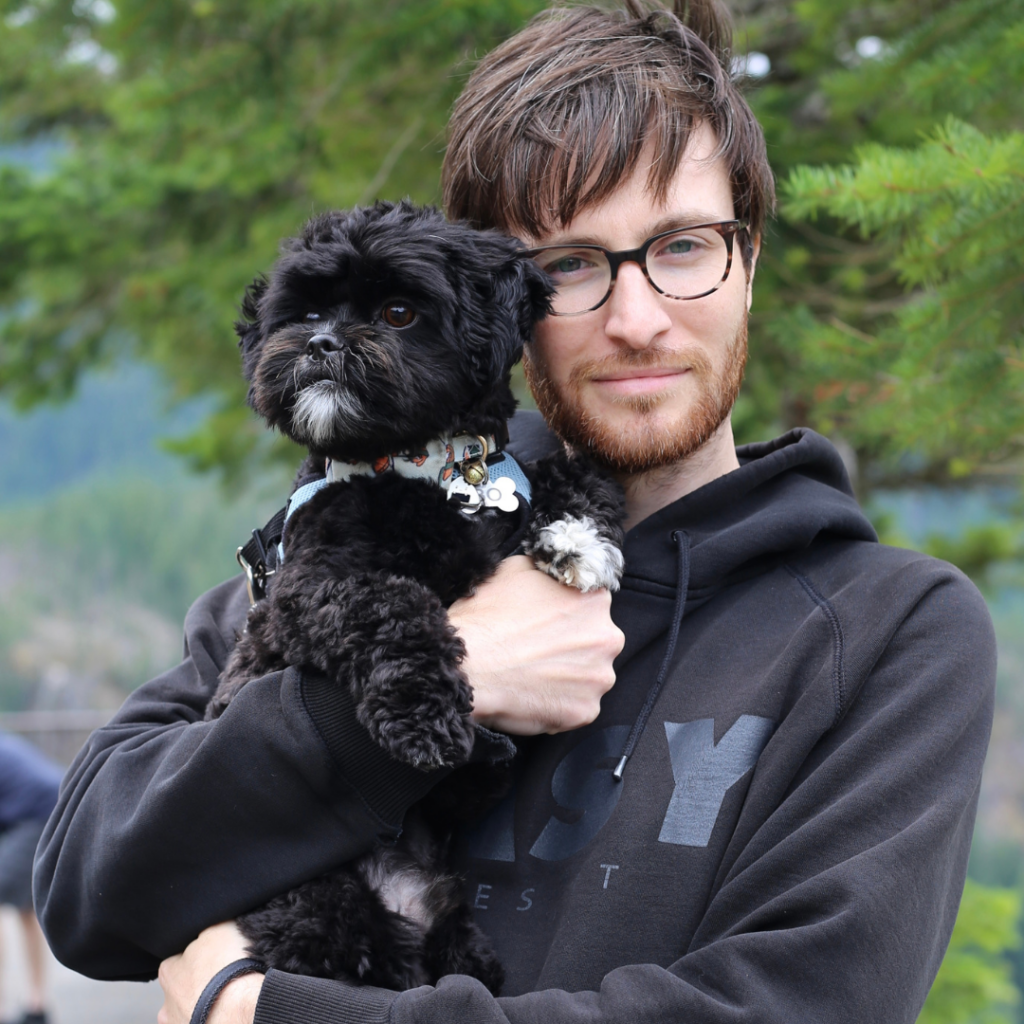
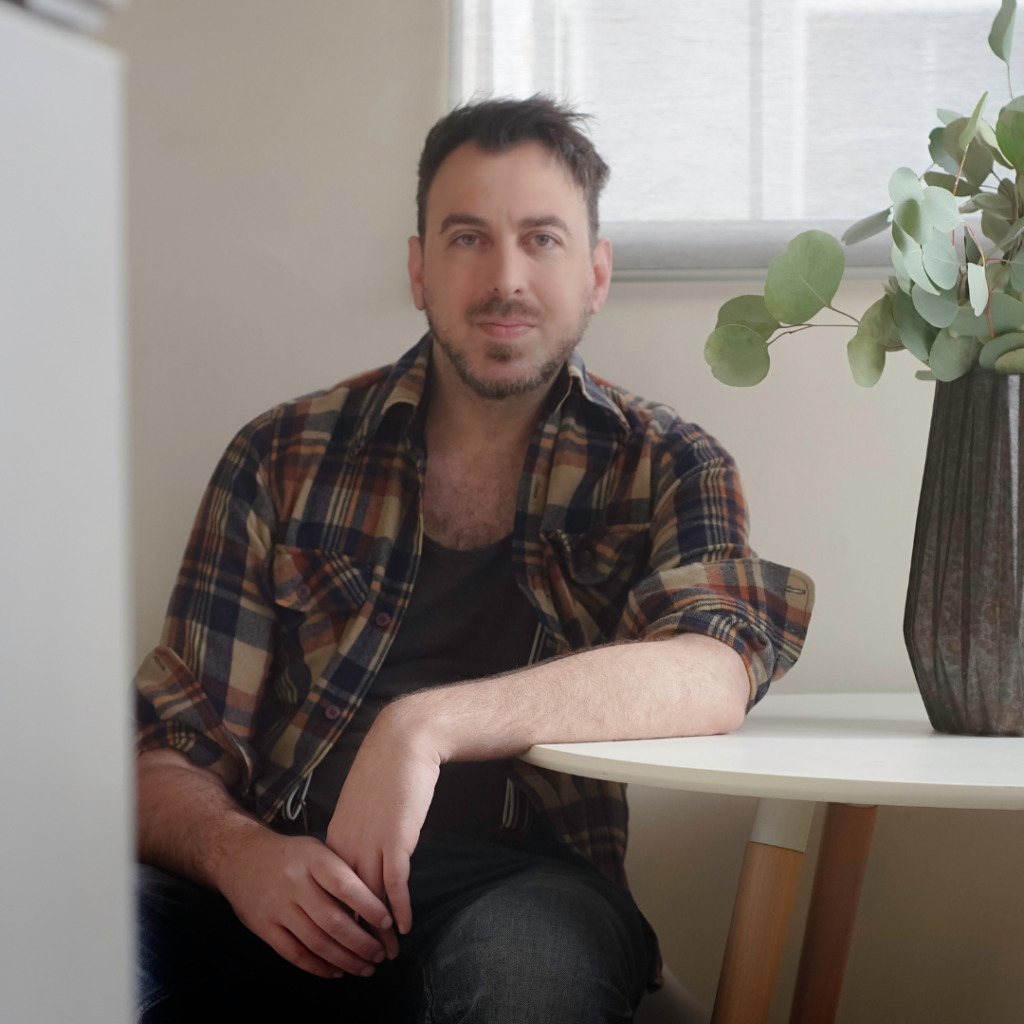
Ethan Feldbau is an award-winning art director, filmmaker, and visual effects artist working in Los Angeles. He’s designed music videos for artists like Moby, Foster the People, Mika, Kavinsky, Frank Ocean, and St. Vincent. His visual effects work can be found in films like the Oscar-nominated “Everything Everywhere all At Once,” “American Hustle,” and “God’s Country.” He is a current BAFTA nominee for his VFX work. Previously, he worked extensively with analogue film production techniques and optical printing before transferring to digital compositing and effects. He holds a BFA in film from Emerson College.
Ben Brewer is a writer, director, and visual effects artist. He has directed music videos for artists such as The War On Drugs, Kid Cudi, Passion Pit, and Justin Bieber, with the video for Bieber’s hit single “Where Are U Now” earning Brewer a VMA for best visual effects. In 2016, Ben co-directed and co-wrote “The Trust” with his brother, Alex — a dark cop comedy starring Elijah Wood and Nicolas Cage. In 2020, Ben served as the lead visual effects designer for A24’s “Everything Everywhere All At Once,” directed by the Daniels. Ben also served as writer on the upcoming Netflix thriller, “Reptile,” starring Benicio Del Toro and Justin Timberlake. He also wrote this biography.
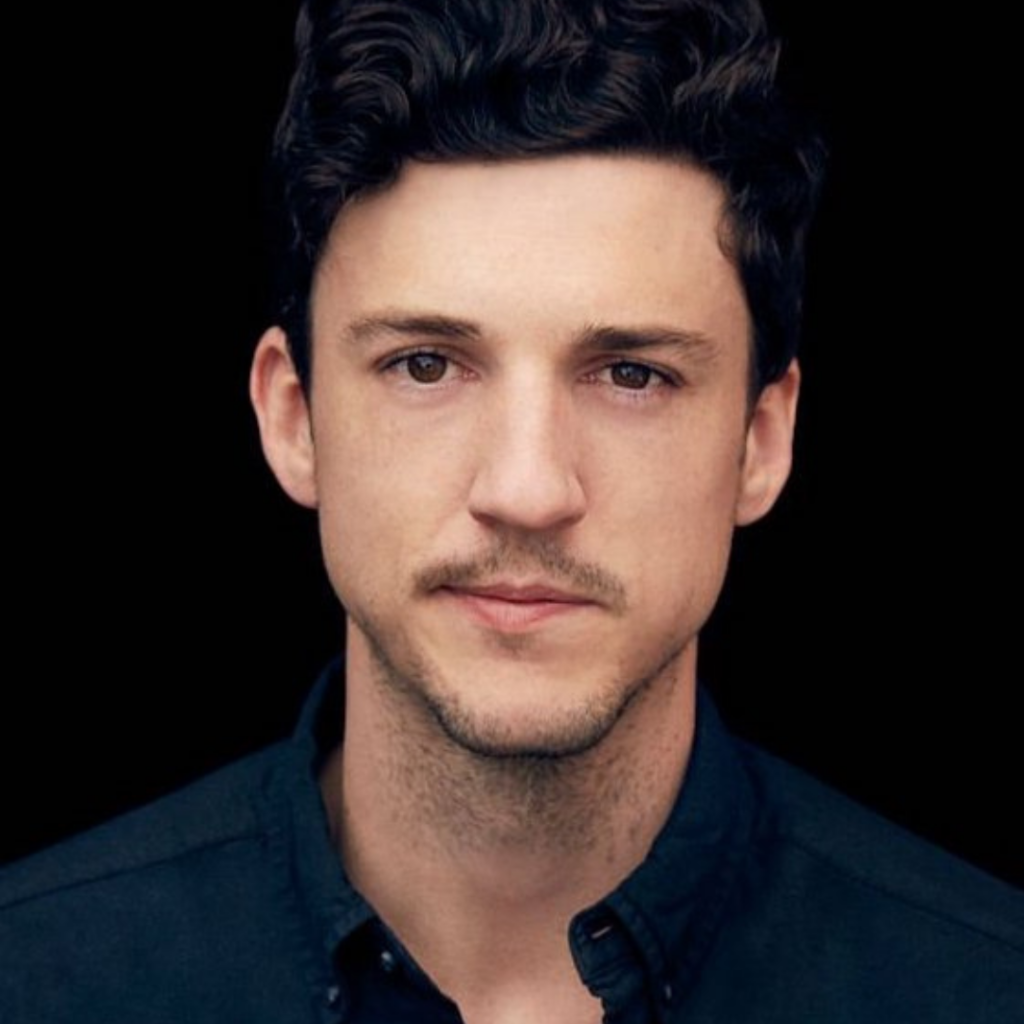
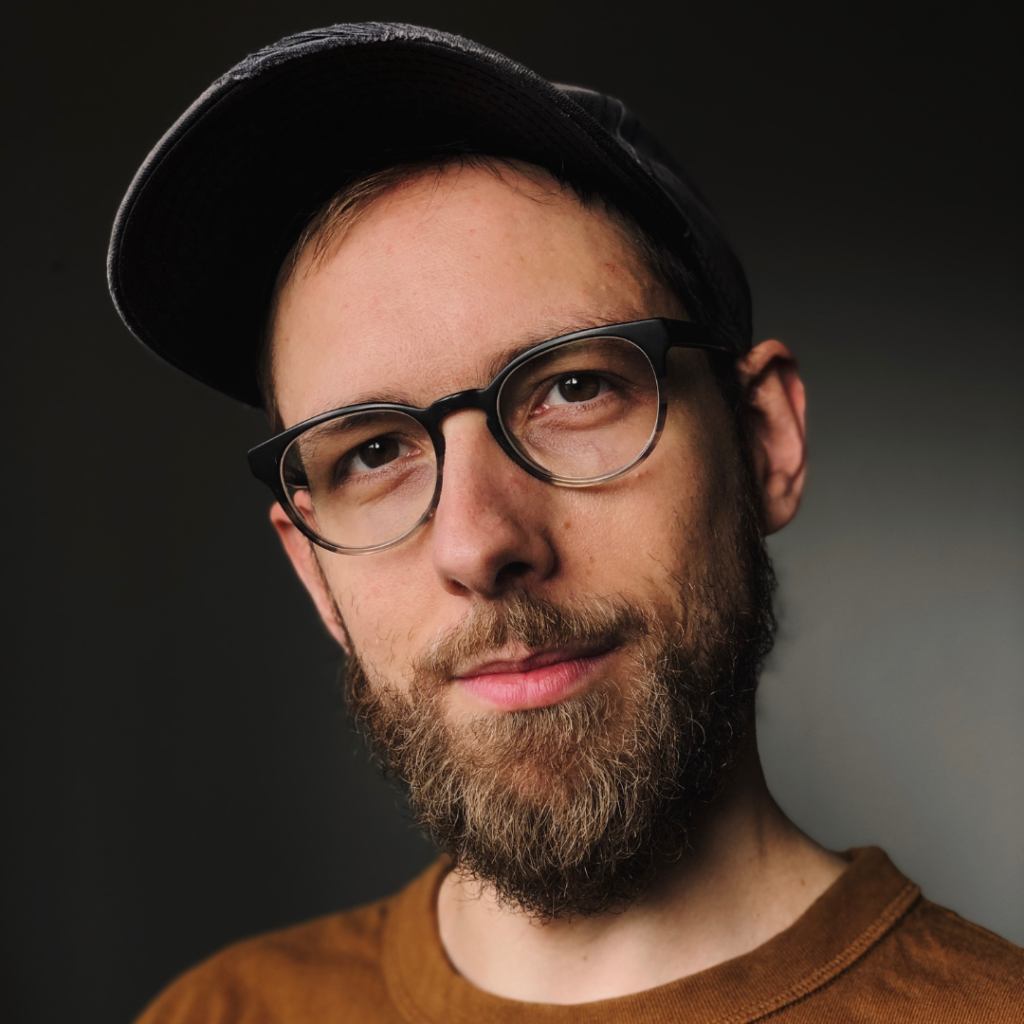
Jeff Desom is a writer, film director, and visual effects artist. Combining live-action, found footage and digital effects, his work has been selected and awarded at a number of festivals around the world. He works between Europe and Los Angeles.
Matt Wauhkonen is a compositor and occasional filmmaker who splits his time between Boston and Los Angeles. His interests include analyzing film form and listening to hyper-pop.
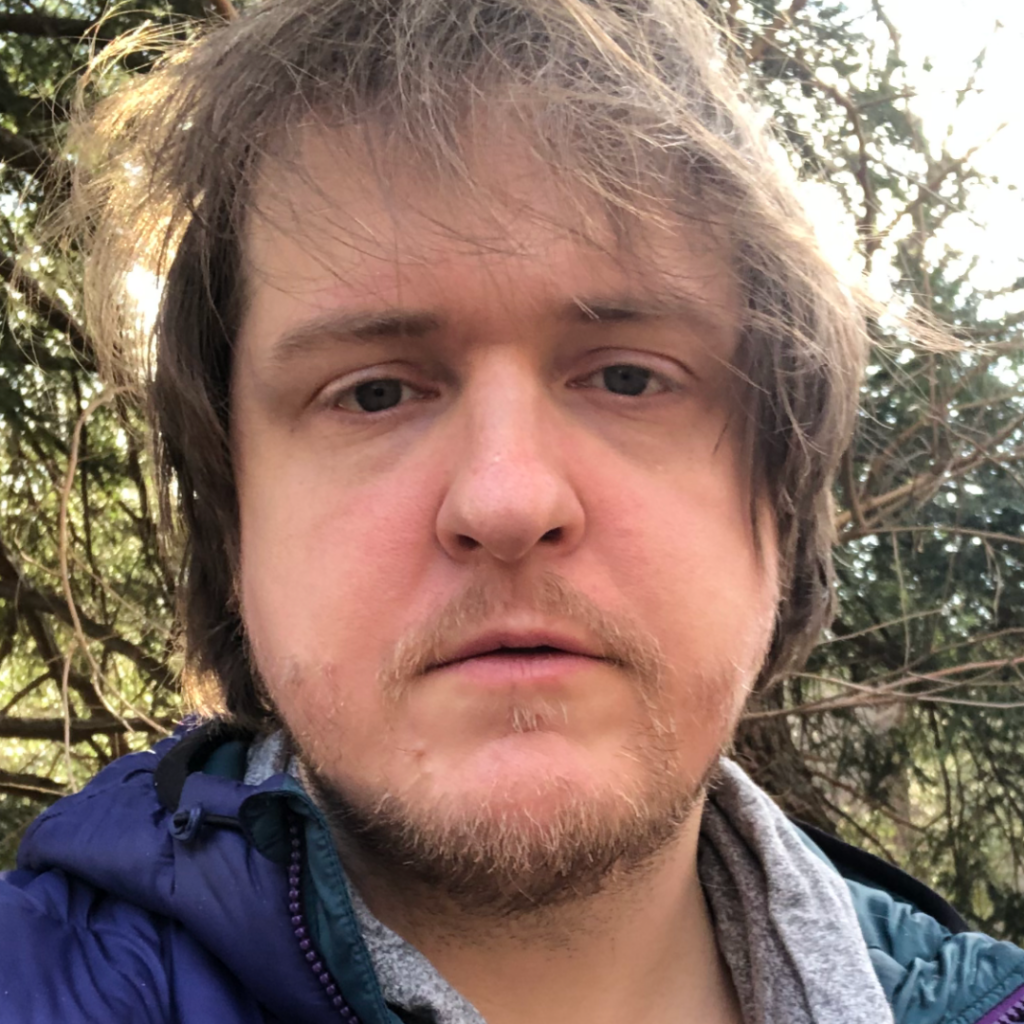
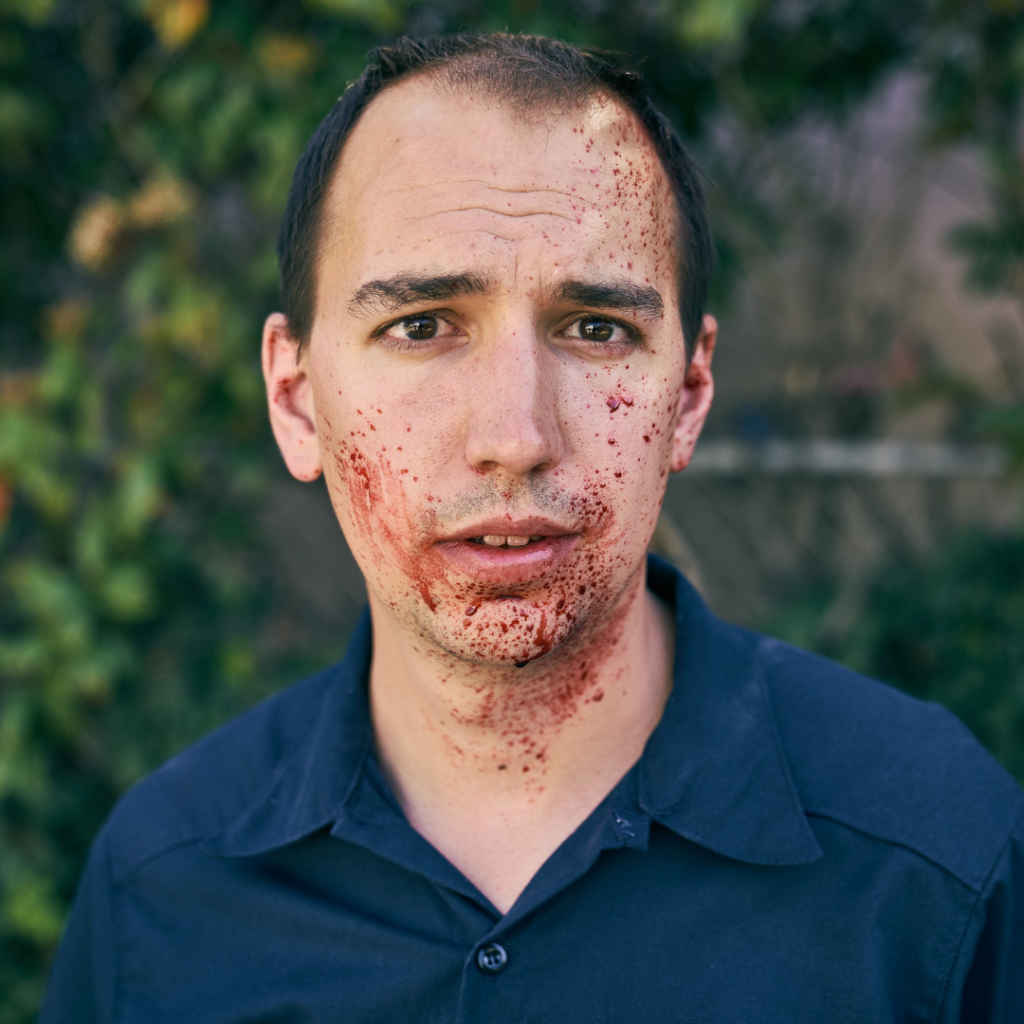
Evan Halleck is a post-production veteran who has edited hundreds of big brand commercials for Toyota and McDonald’s. His VFX work can be seen on “Everything Everywhere All At Once,” “Adventure Time,” and Finneas’ music video “Naked.” He specializes in a lot of stop-motion animated VFX work. In his spare time, he directs comedy films and the award-winning absurd dark comedy short film “Inside Joke” and currently is pitching a finished stop-motion animated pilot he directed called “Shit Show“.
